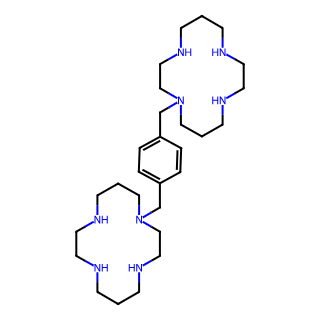- Synthetic anti-infective drugs
- Medications for the digestive system
- Antipyretic and analgesic drugs
- Medications for the blood system
- Medications for the respiratory system
- Anti-allergic drugs
- Medications for the urinary system
- Diagnostic medications
- Immunosuppressive and immunomodulatory drugs
- Vitamins and mineral supplements
- Antioxidants and medications for osteoporosis
- Antiparasitic drugs
- Ophthalmic medications
- Amino acids and their derivatives
- Dermatological medications
- Medications for the circulatory system
- Antitumor drugs
- Medications for the nervous system
- Hormonal and endocrine function-regulating drugs
- Antibiotics
- Others
CAS Number: 110078-46-1




Basic Information
CAS Number: 110078-46-1
Product Name: Plerixafor/AMD-3100
Molecular Formula: C28H54N8 (or C28H66Br8N8O2, depending on the salt or derivative form)
Appearance and Physical State: Off-white powder
Physical Properties
Density: Approximately 1.0±0.1 g/cm3 (values may vary depending on product form and purity)
Boiling Point: 657.5±55.0 °C at 760 mmHg (theoretical value; actual boiling point may be influenced by various factors)
Melting Point: 122-125°C (melting point may slightly differ based on product purity and preparation conditions)
Chemical Properties
Purity: High-purity product, typically above 99%
Stability: Stable under appropriate storage conditions (e.g., refrigerated at 2-8°C)
Solubility: Soluble in DMSO and other organic solvents; appropriate dilution and formulation may be required based on specific applications
Biological Activity and Target Binding
Biological Activity: Plerixafor is a chemokine receptor antagonist that blocks the binding of stromal cell-derived factor-1 (SDF-1alpha) to the CXCR4 receptor
Target Binding Affinity: High affinity for CXCL12 and CXCR4, with IC50 values of 5.7 nM and 44 nM, respectively (values may vary depending on experimental conditions and methods)
Applications and Uses
Medical Use: In combination with granulocyte colony-stimulating factor (G-CSF), Plerixafor is used to mobilize hematopoietic stem cells for the treatment of non-Hodgkin's lymphoma and multiple myeloma. By blocking the CXCR4 receptor, it promotes the release of hematopoietic stem cells from the bone marrow into the bloodstream, facilitating their collection and use in autologous transplantation
Research Use: As a CXCR4 antagonist, Plerixafor also has broad applications in research, where it can be used to study the role of CXCR4 and its associated signaling pathways in cell migration, proliferation, and differentiation

Tai Yau Street, San Po Kong, Kowloon, Hong Kong, China.



